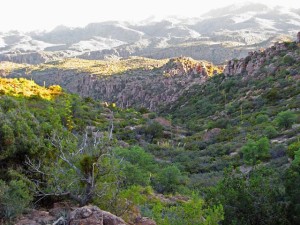
NOT COOL: OAK FLATS AND GRAND CANYON UNDER THE GUN
Of the eleven historic places designated as endangered by the National Trust for Historic Preservation, two are in the state of Arizona:
8th on the list is Oak Flat, near Superior. This site is sacred to several native American tribes and a historic and archeological treasure house. It may be opened to mining under the 2015 National Defense Authorization Act.
6th on the list is the Grand Canyon itself. It faces several threats, ranging from proposed uranium mining to development of a tourist resort. The resort would include an aerial tramway, which would bring some 10,000 people a day to the convergence of the Colorado and Little Colorado Rivers.
Not only would this scar the pristine beauty of the Canyon, but it could also compromise the underground aquifer that provides most of the water to the region.
The tribes whose sacred sites are threatened have organized the Caravan to D.C. to protest the Land Exchange and demand its repeal. A send-off rally is planned for Tuesday, June 30, at the Global Justice Center, 225 E. 26th Street, Tucson. The Caravan will travel along various sacred sites before arriving in Washington, D.C., on July 30.
(Source: Tucson Weekly)
COOLER: G7 MOVE ON CO2 EMISSIONS
Earlier this month, the 7 largest industrial nations, known as the G7, have agreed to take binding measures to limit global warming to 2 degrees Celsius (3.6 F) compared to pre-industrial levels. Five of the countries with the largest CO2 emissions are members of the G7, the U.S. among them.
The agreement is significant, because none of the G7 nations had been willing to consent to binding measures until now.
(Source: US News)
EVEN COOLER: HUMAN RIGHTS AT ISSUE IN GLOBAL WARMING
In a related matter, the Netherlands courts have ruled that the plan of the Dutch administration to cut greenhouse gas emissions by only 14-17 percent by 2020, compared to 1990 levels, falls short of legal requirements and the target reduction should be 25%. The judgment sets an important precedent, because it is based on human rights laws: the plaintiff, Urgenda, argued that “global warming of more than 2 degrees Celsius will lead to a violation of fundamental human rights worldwide”. The European Union as a whole set a target reduction of 40% by 2030.
(Source: Netherlands Broadcasting Foundation (NOS))
STAY COOLEST
Which brings us to ways to beat the summer heat.
- If your area cools off in the evening, take advantage of the cool evenings to cool off your entire house. Open windows and doors with screens to bring the inside temperature down.
- Consider using a whole-house fan. It is a “natural evening air conditioner.”
- In the morning, close up your house and draw blinds and drapes so the house stays darker and thus cooler.
- If you have venetian blinds, close them or angle them upwards. That way, light is reflected up and into the room and direct rays of the sun are not let in.
- Set your thermostat to 78 degrees Fahrenheit when you are home and 85 degrees when you are away. For the infirm, elderly, and those who have trouble maintaining body temperatures (such as diabetics), set your thermostat lower (72 to 75 degrees) when you are home.
- Check that ceiling fans run counterclockwise, so that cold air is drawn up.
- Turn off lights, electrical devices and electronics when not in use.
- A good trick to cool down is running a fan across a bowl of ice.
- Hanging wet sheets across the window will do a lot to cool down a room.
SLEEPING
- Choose cotton nightwear over nylon or silk; looser is better.
- Stick sheets in freezer for a few minutes
- Put a cold water bottle in your bed
- Hot air rises, so sleep close to the floor
- Drink 8 ounces of water before going to bed
PREVENTING HEAT STROKE
Don’t wait until you’re thirsty to drink. Don’t rely upon thirst as an indicator of your need for water; it’s not reliable in very high heat.
Don’t drink liquids that contain caffeine, alcohol, or large amounts of sugar – these actually cause you to lose more body fluid. Also, avoid very cold drinks, because they can cause stomach cramps.
Pay attention to warning signs of heat stroke: red, hot sweaty skin, cramps, lightheadedness and fatigue will occur long before heatstroke.
If you see someone with these symptoms, call for an ambulance. Get the victim out of the heat. Loosen or remove clothing, wrap the person in wet towels or clothing, and apply ice packs around the neck,the groin and under the arms and knees (where the blood flow is greatest and closest to the surface). If the victim seems mentally impaired, which is common in this situation, do NOT try to make the person drink. as there is a serious choking hazard.
(Sources: Consumer Energy Center, Greatist)
HAPPY INDEPENDENCE DAY FROM ALL THE REAL PEOPLE AT KXCI!
And please cut those 6-pack rings, so they won’t strangle some little animal.
THIS WEEK’s BROADCAST

